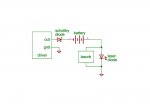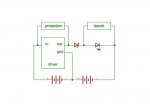- Joined
- Mar 18, 2012
- Messages
- 173
- Points
- 0
I think this will fit, but the currents are probably too low?
ELL5PR1R5N - PANASONIC - CHOKE COIL, SMD, 1.5UH, 30%, 2 | Newark
The major limit is the 40°C rise current (2.5A). You should expect this inductor become (very) hot when the output is at 1.8A but you can try it...







